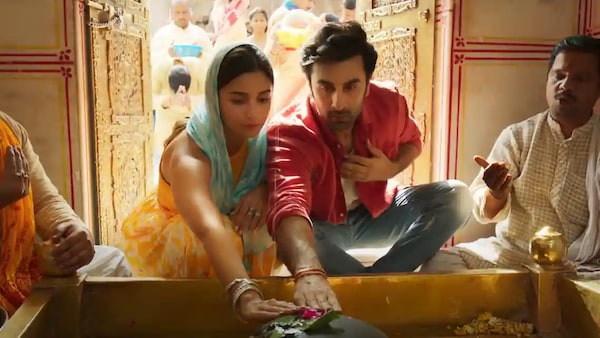Brahmastra: Part One—Shiva review: A kinder, gentler spectacle

- Uday Bhatia
LiveMint
Last Updated: 06.14 PM, Sep 09, 2022
Brahmastra: Part One—Shiva opens with a scientist, played by Shah Rukh Khan, being paid a visit by a trio of supernatural assassins. Turns out the scientist has special powers too, and there’s an extended fight sequence, ending in his capture. We later find out his name: Mohan Bhargav. Khan had played a Mohan Bhargav in Swades (2004), also a space scientist, also driven by a sense of duty. The similarities between the two characters end there—but it’s enough, a wisp of a suggestion that nestled comfortably in my brain.
I mention this also because Ayan Mukerji’s film is hardly this understated in its other borrowings. Early on, there’s a quick shout-out to Mr. India (1987), a rare homegrown superhero film. From there on, it’s spot-the-Hollywood-blockbuster, with narrative devices and structures nicked from a variety of franchises. At the film’s heart is the idea of a divine Brahmastra, whose pieces, when reattached, will be an all-powerful weapon in the hands of the long-dormant Deva. Infinity Stones, you say, scattered across the realm, capable of granting their wearer unimaginable powers when combined? Never heard of 'em.
Deva is a giant statue in this, the first ‘Astraverse’ film, though sentient enough to send the witch-like Junoon (Mouni Roy) to do his bidding. It’s Junoon who subdues Mohan Bhargav and his vaanarastra at the start of the film, extracting from him the identity of another member of the secret society called the Brahmansh. This torture appears in a violent vision—not the only time the film reminded me of Harry Potter—to Shiva (Ranbir Kapoor) at just the wrong time, when the carefree DJ is showing curious rich girl Isha (Alia Bhatt) his nifty-looking loft in a chawl. The dream knocks him out. When he comes to, he decides to go to Varanasi to warn the man whose name was given up (Nagarjuna), and who has a fragment of the Brahmastra. Isha, already smitten, tags along (there’s no indication she has a job or people who are worried she’s taken off with a broke DJ she just met).
After a series of close shaves with Junoon and her two burly assassins, Isha and Shiva are cornered at the gate of an ashram in the Himalaya they’ve been told to seek out. Shiva—who's impervious to fire—produces a blast of flaming energy, blowing away the advancing henchman. They’re taken in by the ashram’s leader, Guruji (Amitabh Bachchan), who runs the place much like Professor X (guru is ‘teacher’ in Hindi) and the school for mutants in the X-Men movies, with young astra-wielders taught to harness their skills. Guruji is also head of the Brahmansh, and encourages Shiva to realize his destiny as the powerful agniastra.
Hindi cinema has been building to a film like this for some time. Hollywood superhero films routinely open big across the country now. Kids actually want to see them; no one’s calling for their boycott. At the same time, Hindu religious and mythological iconography has become increasingly central in Hindi films. Brahmastra merges these worlds: the framework and splashy effects of a Hollywood movie retrofitted onto a story populated with Hindu gods and goddesses. Tsui Hark tried something similar when he made Zu: Warriors from Magic Mountain (1983), combining wuxia and Chinese folk tales with Hollywood effects. But that film was unlike anything Hollywood was doing at the time, whereas Indian and foreign viewers alike will recognize the familiar foundations of Brahmastra, even if the construction on top is new.
The CGI work in Brahmastra is shaky in places but better than what the trailers led me to expect. When in doubt, Mukerji fills the screen with pretty lights. I wonder how Indian audiences, fed on the hard-edged sagas of Rajamouli and the bloodfests of the southern cinemas, will react to this softer, kinder spectacle (I knew it was a matter of time before someone said “love is the greatest astra”). Good-vibe stories aren't exactly killing at the box-office lately, and Brahmastra is all soft edges and encouragement. Bhatt and Kapoor have a warm rapport, if not exactly chemistry. Their love goes straight from tiny flame to conflagration—she barely knows him at all when she declares, “Tum zindagi se shikayat nahi, mohabbat karte ho” (You don’t complain about life, you love it). Even Junoon has the comforting hamminess of a TV soap antagonist yelling at the bahu for letting the milk boil over.
It’s ironic that right-wing trolls have been trying to ban a film that works harder than anything in recent memory to make Hinduism look cool. Both Shiva and Isha are enthusiastic temple-goers. Her explanation for why he should let her come along to Varanasi is that her name also means Parvati, the god Shiva’s wife. One dance number has a chorus of “Om deva deva, namah namho namah”. The various astras take the shape of Shiva, Brahma, Nandi, Hanuman. Every now and then, one of the five cinematographers (what’s up with that?) gives us a loving closeup of a heavenly idol, as if this were Jai Santoshi Maa. Come to think of it, that’s a decent rhyme for love storiyaan.

 Premium
Premium